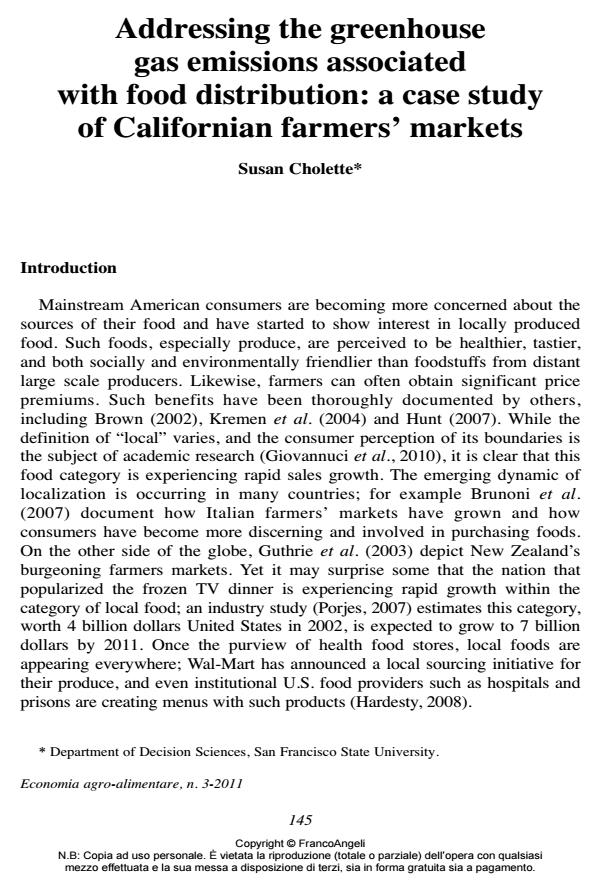Addressing the greenhouse gas emissions associated with food distribution: a case study of Californian farmers’ markets
Titolo Rivista ECONOMIA AGRO-ALIMENTARE
Autori/Curatori Susan Cholette
Anno di pubblicazione 2012 Fascicolo 2011/3
Lingua Inglese Numero pagine 25 P. 145-169 Dimensione file 936 KB
DOI 10.3280/ECAG2011-003009
Il DOI è il codice a barre della proprietà intellettuale: per saperne di più
clicca qui

FrancoAngeli è membro della Publishers International Linking Association, Inc (PILA)associazione indipendente e non profit per facilitare (attraverso i servizi tecnologici implementati da CrossRef.org) l’accesso degli studiosi ai contenuti digitali nelle pubblicazioni professionali e scientifiche
American consumers’ growing taste for locally produced food has resulted in the proliferation of farmers’ markets in the U.S. While benefits abound, the very success of these markets has created an inefficient network; farmers drive long distances with small cargos multiple times each week. Not only does this increase costs, but on a per unit basis, the energy usage and resultant greenhouse gas emissions associated with supplying farmers’ markets can be greater than those associated with the equivalent supermarket distribution. In this case study, we investigate the outbound journey of food from a farm to a farmers’ market and compare it to corresponding conventional journeys, finding farmers’ market distribution indeed produces greater emissions. We then model Northern California’s farmers’ market network, solving a mixed integer transportation problem to quantify the aggregate distance travelled. We next insert a consolidation center. Farmers can transport goods either directly to the market or to this center for aggregation with other farmers’ offerings. Solving the new model shows that significant savings are possible. While admittedly rife with implementation barriers, such a solution could allow small farmers to profit from economies of scale while still retaining their independence and preserving the diversity of the markets. We view this study as a first step towards reworking the system to enable consumers and producers alike to enjoy the benefits of farmers’ markets while reducing costs and greenhouse gas emissions.
Parole chiave:Farmers’ markets, greenhouse gas emissions, network optimization, supply chains, distribution
Jel codes:Q1, Q5, R4
- Recent advances and opportunities in sustainable food supply chain: a model-oriented review Zhanguo Zhu, Feng Chu, Alexandre Dolgui, Chengbin Chu, Wei Zhou, Selwyn Piramuthu, in International Journal of Production Research /2018 pp.5700
DOI: 10.1080/00207543.2018.1425014 - Sustainability Perception of Local Extra Virgin Olive Oil and Consumers’ Attitude: A New Italian Perspective Bianca Polenzani, Chiara Riganelli, Andrea Marchini, in Sustainability /2020 pp.920
DOI: 10.3390/su12030920 - Consumer perceptions and attitudes towards Farmers' Markets: the case of a Slow Food "Earth Market"® Claudia Bazzani, Daniele Asioli, Maurizio Canavari, Elisabetta Gozzoli, in ECONOMIA AGRO-ALIMENTARE 3/2017 pp.283
DOI: 10.3280/ECAG2016-003003
Susan Cholette, Addressing the greenhouse gas emissions associated with food distribution: a case study of Californian farmers’ markets in "ECONOMIA AGRO-ALIMENTARE" 3/2011, pp 145-169, DOI: 10.3280/ECAG2011-003009